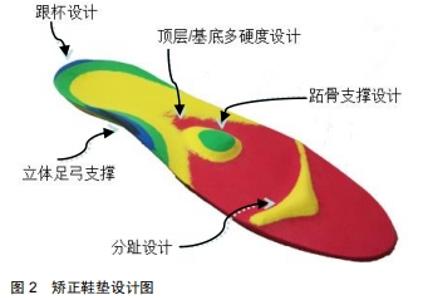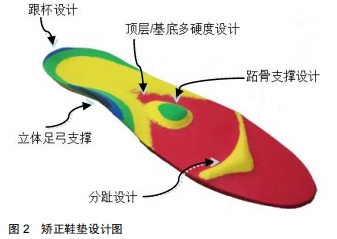Chinese Journal of Tissue Engineering Research ›› 2020, Vol. 24 ›› Issue (23): 3744-3750.doi: 10.3969/j.issn.2095-4344.2691
Previous Articles Next Articles
Design principle and biomechanical function of orthopedic insoles
Zhang Xinyu1, Xing Xinyang2, Huo Hongfeng1, 3
- 1Physical Education College, Hebei Normal University, Shijiazhuang 050024, Hebei Province, China; 2Hebei Sport University, Shijiazhuang 050041, Hebei Province, China; 3Provincial Key Lab of Measurement and Evaluation in Human Movement and Bioinformation, Shijiazhuang 050024, Hebei Province, China
-
Received:2019-10-29Revised:2019-11-13Accepted:2019-12-20Online:2020-08-18Published:2020-07-30 -
Contact:Huo Hongfeng, Senior experimentalist, Master’s supervisor, Physical Education College, Hebei Normal University, Shijiazhuang 050024, Hebei Province, China; Provincial Key Lab of Measurement and Evaluation in Human Movement and Bioinformation, Shijiazhuang 050024, Hebei Province, China -
About author:Zhang Xinyu, Master candidate, Physical Education College, Hebei Normal University, Shijiazhuang 050024, Hebei Province, China -
Supported by:Hebei Province Science and Technology Support Project, No. 16275709 (to HHF); the Natural Science Foundation for the Youth in Hebei Provincial Department of Education, No. QN2017343 (to HHF); Key Project of the Scientific Research Fund of Humanities and Social Sciences School of Hebei Normal University, No. S2017Z06 (to HHF)
CLC Number:
Cite this article
Zhang Xinyu, Xing Xinyang, Huo Hongfeng. Design principle and biomechanical function of orthopedic insoles[J]. Chinese Journal of Tissue Engineering Research, 2020, 24(23): 3744-3750.
share this article

2.1 矫正鞋垫的设计原理 矫正鞋垫运用物理矫正法对足部结构的改变进行预防与治疗,不同的患病情况、外界环境、运动形式等会显现出不同的足底压力特征及身体姿势,矫正鞋垫的设计应根据人体足踝、膝关节、脊柱等部位具体的姿势特征、结构特征及足底压力特征,有针对性的在足前掌、足弓和足后跟3个主要部位做出调整。 2.1.1 调整足底受力点,分散足底压力 足异常的常见反应是足部形变及疼痛,正常情况下在运动过程中足与地面接触时,足部受力在不同运动阶段正常分布于足底各位置[4],为人体运动提供了动力,保障运动的顺利完成。但足部结构异常导致足部受力不均,压力集中到足部某一区域产生疼痛现象,影响人体的活动能力,促使人体形成代偿机制来弥补由于足结构改变、足踝功能异常及缺失所导致的活动能力下降[5]。矫正鞋垫能够调整足底负重点位置,转移足部受力集中点,对足受力异常部位提供受力补偿,合理分散足底压力,达到减小疼痛的效果。 2.1.2 支撑足弓,提高缓冲能力 足部的有效运动依赖于足部结构的完整性, 在足部传递力量过程中足弓的功能至关重要,有助于减震和分散传递足部的力量[6]。足部形态影响足部受力,矫正鞋垫能够为足弓提供支撑,改变足底接触面积,合理分散足前掌与后跟过大的压力,减小跖骨头和足跟的压强峰值及压强-时间积分,缩小压力相对集中的区域,保证足部受力正常,达到预防与治疗足部疾病的目的[7-8]。 2.1.3 改善下肢力线,提供稳定及支撑 下肢生物力学轴线指在站立姿态下经过踝关节中点、膝关节中点、髋关节中点的连线[9],各关节轴线存在正常角度范围。在人体步行的支撑初期,足跟触地时触地点位于踝关节重心外侧,产生对距下关节的外翻推力,导致距下关节外翻、足旋前,正常旋转角度为4°-6°,超过6°即为过度旋前[10]。不正确的运动模式及身体姿势会导致足踝及下肢结构与功能异常,足长期处于异常状态会导致足趾过度倾斜、足弓异常、胫骨及股骨旋转、膝关节关节面压力及翻转程度加大、骨盆倾斜及旋转、人体重心发生偏移,进一步引发对侧肩关节倾斜来代偿足部过度翻转,产生代偿性姿势紧张[11]。矫正鞋垫能够通过控制足的翻转来限制距下关节旋转角度,调整踝关节轴线角度,使足跟与跟腱、跟腱与小腿两条力线重合,内外踝与跟腱之间的距离趋于一致,使得行走时人体两侧力线合理,足趾、踝关节、膝关节、肩关节恢复正常位置,减少各关节代偿,保持人体重心处于正确位置,维持人体各关节正常形态、受力,稳定松弛关节,提高人体平衡能力[12]。 2.1.4 改善本体感觉,提高足部舒适性 足部感觉包括外界刺激感觉及内部刺激感觉[4],外界刺激感觉主要指由于外界环境因素引起的足部感觉变化,如不同地面、不同鞋或鞋底材料、款式、温度、湿度及运动形式等因素改变对足部刺激所产生的不同感觉;内部刺激感觉主要指由于足踝、下肢等骨骼肌、韧带、关节结构异常或损伤等因素导致的足功能异常或缺失所引起的不同感觉,如拇外翻、跖通症、足底筋膜炎、足踝过度翻转等。矫正鞋垫能够根据人体不同的需求有针对性的改变矫正鞋垫的材料、形状等,达到降低冲击、缓解局部压力过大、稳定和支撑足部关节等作用,使足能够适应不同外界环境、运动形式及关节结构的改变,保证足踝及下肢的正确运动模式[13],提高人体站立、行走、跑跳等运动的舒适感。 2.2 矫正鞋垫的制作方式 矫正鞋垫是当前最常见的预防足部疾病、矫正足部形态、维持足部健康的辅助性器具,见图2,按照制作方式可分为预制型、半定制型和定制型3类[14]。 "


2.2.1 预制型 预制型矫正鞋垫是对足部主要起到预防作用,能够对轻微足部疾病进行矫正的辅具,多用于一般群众。但其存在一定的局限性,仅能够为足的特定区域提供一定的支持或减震作用。预制型矫正鞋垫的构件主要包括贴片、局部垫、凹槽、展边垫、挖槽、补缺垫、延伸垫、后跟垫、深后跟杯、跖骨垫等[15]。制作及使用时不需要对鞋垫的外形进行修整,可供大众直接使用,用于批量生产,价格相对较低。 2.2.2 半定制型 半定制型矫正鞋垫是指根据患者患病特点有针对性的对足部异常形态及受力进行矫正的辅具,多用于医疗机构。半定制型矫正鞋垫主要包括2部分,一部分为主体鞋垫,另一部分为基础构件,包括横弓、纵弓、外侧楔形垫、后跟补正垫、补高垫等[16]。制作时依据患者的患病特征对矫正鞋垫进行不同程度的打磨与改造,根据需要将基础构件黏附在主体鞋垫之上,对患者足部提供有针对性的支撑,有效调整足部力学结构,分散足底压力集中区域。此类矫正鞋垫制作相对简便、价格适中,在医疗领域得到了广泛应用。 2.2.3 定制型 定制型矫正鞋垫是指对患有复杂足部特征及病症患者进行制作的个性化矫正鞋垫,多用于科学研究项目中。制作过程整体上包括前期准备、整体姿态检查、足部生物力学检查、步态分析、获取足部形态数据、鞋垫材料选择、鞋垫的加工与修正、成型。定制型矫正鞋垫根据患者足部形态及受力的具体数据进行制作,完全符合患者足部特点,能够使患者足、膝关节及脊柱等部位得到全面性、整体性的预防与矫正。数字化技术使矫正鞋垫的制作更加精准科学[17-18],但制作过程复杂、步骤繁多、价格昂贵,主要应用于私人订制及科研领域。 2.3 矫正鞋垫的康复功能 2.3.1 矫正鞋垫对足踝畸形等病症的康复功能 内部遗传因素、外部环境及穿鞋不适、不正确的运动模式及身体姿势等是引起足部力学结构改变的主要因素。拇外翻、扁平足、高足弓、足底筋膜炎、足踝过度旋转等是足部的常见疾病。 拇外翻常用拇外翻角度来衡量,小于16°为正常足,介于16°-30°之间为轻度拇外翻,大于30°为重度拇外翻,成人中特别是女性的患病率高达33%[19]。主要表现为第1跖列位置不正、跖趾关节内侧粗隆突出、跖骨部位压力增大,影响了第1跖趾关节的机械转位,进而造成第1跖列、第2跖骨头下的疼痛、位置不稳等并发症的产生[20]。拇外翻无法通过自体修复,早期可通过矫正方式进行治疗,矫正鞋垫通过改变拇指两侧压力改善第一跖趾关节形变及受力,为跖骨部位提供支撑,重新分配跖骨处过多的压力[21]。由于人体运动是一个动态的过程,足与跖骨垫的匹配程度降低,跖骨支撑垫存在一定局限性,动态压力鞋垫可以将鞋垫与运动中跖骨较好的吻合,增大跖骨接触面积,减小跖骨头过大的压力,有效缓解疼痛。对于跖痛患者,运用矫正鞋垫治疗3个月的目测类比评分较传统的药物治疗方法显著降低,疼痛及步态得到有效改善[22]。 肥胖儿童、老年人是扁平足的高发人群,老年人扁平足发病率高达89%[23-24]。扁平足主要表现为足弓塌陷或消失,距下关节过度旋前,前足旋前外展,后足外翻,第二跖骨位压强较正常足增大约20%[13],足弓不能提供有效的支撑作用,运动过程中通过增加踝关节及膝关节的背屈与屈曲角度来代偿足弓塌陷所导致的支撑及缓冲功能减弱。矫正鞋垫通过调整扁平足负重点位置转移足底压力过高点,缩小足部压力集中区域,分散压力集中部位压力,其中足后跟减小最多,通过调整足前掌旋前与足后跟外翻程度使距下关节旋前角度得到有效控制,维持足部力学平衡。硬度为50°shore C、支撑高度为24 mm的矫形鞋垫对于降低扁平足人群前掌区域峰值压强的作用效果最为明显[25]。 高足弓主要表现为内侧纵弓过高,足弓部位劲度系数增大,弹性及活动度降低,不能有效承受人体质量及缓冲运动给足带来的冲击,与地面接触面积小于正常足,足前掌及足后跟压力增大,踝关节肌力降低[26],损伤风险增加。对于高足弓症状,矫正鞋垫为足弓提供支撑,增加足底接触面积,使受力面积增大,合理分散足底压力,有效减小高足弓患者足前掌、后跟压强和冲量及跖骨处过高的压力[27]。 足底筋膜作为足部能够因足弓压缩和跖趾关节伸展而被拉长的结构,起到了储存及释放弹性势能的作用,在运动过程中的不同阶段,可以根据不同的应力调整足部的弹性功能,足弓回弹的功能主要是产生重力势能和动能以推进身体向前运动[28]。足部长期受力异常会导致足底筋膜跟骨止端受到重复性损伤,引起足底筋膜炎的产生,主要表现为持续性足跟疼痛,足跟着地时承受压力较大,主要依靠足的旋前机制分散足底压力集中区,加大了足底筋膜张力,导致筋膜退变、纤维化,易发生于长跑运动员、老年人及肥胖、糖尿病患者等人群[29-31]。矫正鞋垫通过提高足弓承重及减震作用,减缓运动过程中动态力对足部直接产生的过高的地面反作用力,合理分散足底压力,在下肢负重时有效降低足底筋膜所受拉力,减少反复牵拉对足底筋膜的伤害,达到减轻疼痛、恢复足部生物力学平衡的效果[32]。矫正鞋垫结合康复运动训练对于足底筋膜炎病症康复效果显著,经过1个月与6个月治疗有效率分别高达56%和80%[33]。 足踝过度旋转表现为足旋前及足旋后,适度的旋前、旋后使足能够有效的发挥推动及缓冲作用,足踝过度旋转会导致各关节产生代偿性损伤,步态及身体姿势改变[10]。重度旋前表现为足过度外翻、外展、背屈,距骨外翻外展应力加强,足内侧结构受到强力牵拉,导致踝关节挤压应力加强,缓冲能力下降,蹬地推进作用减小,影响下肢力线方向,足部旋前还会引发功能性长短腿的产生,两者呈显著正相关关系[10]。重度旋后表现为足过度内翻、内收、跖屈,导致跖骨及后跟足底压力增加,足弓弹性降低,吸收地面冲击力能力及关节活动度减小,稳定性降低,加大损伤概率。跟骨及距骨位置的改变是造成足踝翻转的主要原因,矫正鞋垫通过调整跟骨及距骨的位置、角度等,限制距下关节的过度翻转,起到保护、稳固及支撑作用,降低足踝损伤概率,达到预防及矫正足踝畸形的效果[34]。 2.3.2 矫正鞋垫对膝关节畸形等病症的康复功能 儿童肥胖、书包过重、走路姿势不正确,老年人身体功能下降及女性长期穿着高跟鞋等是导致膝关节病症的原因。膝内翻和膝外翻是膝关节的主要病症。下肢受力异常会导致人体下肢活动度受限,行走的稳定性下降[35],促使人体形成代偿机制,导致足部及下肢结构、功能的改变,加大损伤及跌倒风险。长期处于不正确的结构及身体姿势,不仅会加剧足踝、膝关节的翻转程度,严重的还会导致膝骨关节炎等并发症的产生。 在站立姿态下,膝内翻与膝外翻患者下肢力线异常,股骨和胫骨发生翻转,膝内翻股胫角<182°,外翻者股胫角>184°[36-37]。膝内翻患者在行走支撑期膝内翻角度明显增大,伴随步态的足偏角减小,足底压力中心轨迹晃动幅度增大,改变正常步态及平衡,内侧股骨与胫骨连接处为膝关节受力的集中部位,膝关节内收幅度增加,存在膝关节疾病患者的膝内收力矩峰值与足底外侧压力峰值约为正常人的1.4和1.5倍[38]。膝外翻患者股骨关节面向外倾斜,身体质量过多集中于膝关节外侧关节面,导致膝关节及足部受力异常,下肢力线偏转,影响行走稳定性,膝外翻居儿童下肢畸形发生率第2位[35-39]。足底平面的倾斜造成膝关节内翻与外翻,足部形态及受力异常是导致足底平面变化的主要原因。矫形鞋垫通过调整足部翻转程度控制距下关节旋转角度,平衡足部受力,使踝关节力线处于正常位置,保持踝关节与下肢受力一致,形成正确的下肢力线,在行走过程中确保双侧力线合理,进而有效调整胫骨、股骨及膝关节翻转程度,减小膝关节内外侧关节面过大压力,避免形成下肢代偿机制,提供有效的力学支撑,恢复下肢生物力学平衡,改善人体行走步态和姿势,提高行走稳定性,达到矫正作用。 膝骨关节炎多发生于老年人群,并随年龄的增长患病风险逐渐增高,女性占比高达70.81%[40]。膝骨关节炎引起本体感觉及下肢肌力减退,导致平衡能力降低,患者通过改变步态、增加姿势的摆动频率来提高对下肢运动的控制能力及对疼痛的忍受能力[41]。对于膝骨性关节炎患者,使用矫正鞋垫有效减缓疼痛的有效率高达61%[42],主要是减小膝关节面股骨与胫骨的挤压程度及负荷。矫形鞋垫可以给予前足内侧及足后跟外在支撑力,增加后足弹性,提高足部的柔韧性,减轻局部过度的压力,通过调节膝关节的角度加大膝关节间隙,减轻膝关节内侧间室负荷,增加步长、步宽、踝跖屈力矩及踝部力量,纠正患者步态,提高平衡及活动能力[43-44]。与按摩、激光治疗等方式相比,矫形鞋垫的治疗效果更加明显,经过6-10个月的治疗,股骨胫骨外侧角由平均187°改善为平均176°,矫正11°[45];larson评分由使用矫形鞋垫前的平均70.4分提高至平均90.7分;lysholm评分从使用前的平均75.0分提高至平均92.3分,有效改善了膝关节疼痛[45]。 2.3.3 矫正鞋垫在脊柱畸形等病症的康复功能 下肢生物力学轴线异常会引起代偿性脊柱疾病的产生,高足弓、扁平足、距下关节过度旋转、膝关节内外翻等症状均会引起下肢力线异常,脊柱侧弯是脊柱部位的常见病症。 人体站立姿态下脊柱存在一定的弯曲角度,脊柱侧弯患者脊柱偏离纵向轴线,形成异常的侧向曲线,侧向弯曲大于10°即为脊柱侧弯。弯曲的脊柱通过骨盆对地面产生作用力,此作用力大小及方向与正确作用力相偏离,异常作用力加剧脊柱弯曲程度。脊柱侧弯患者常伴有双下肢不等长、胫骨与股骨旋转、膝关节疼痛与翻转、骨盆偏转、肩关节倾斜等症状,导致人体平衡能力下降[46-47]。足踝及膝关节疾病与脊柱疾病相互影响,人体在活动过程中,足踝及膝关节疾病的存在导致人体负重不对称,重心发生偏离,迫使人体依靠脊柱来维持身体平衡,使脊柱部位形成代偿机制,导致脊柱形态及受力异常,肩关节随之倾斜,进而加剧下肢力线异常程度。脊柱侧弯是青少年群体最常见的脊柱疾病[48-49],影响其身体正常生长发育。矫正鞋垫通过调整站立姿势下跟骨的位置减少距下关节旋转及足部翻转程度,使足踝受力平衡,形成正确的上传力线,改善膝关节翻转程度,使人体重心准确落在承重位置,避免形成脊柱代偿机制,使脊柱受力正常,有效调整生物力学轴线,提高身体平衡能力,重新建立良好的人体生物力学姿态。 2.3.4 矫正鞋垫对儿童偏瘫型脑瘫病症的康复功能 偏瘫型脑瘫指头部非进行损伤性所致的大脑功能失衡病症,导致儿童感知觉、肢体肌肉张力及行为异常,主要表现为身体姿势、运动不对称等现象[50-51],小腿三头肌痉挛是引起姿势异常的主要原因,导致足踝畸形、外翻、疼痛等问题,严重影响平衡及稳定性,儿童行走能力下降[52-53]。 由于儿童体质的特殊性,对于偏瘫型脑瘫、内旋或画圈步态等疾病,保守型矫正治疗结合康复训练逐渐成为儿童治疗的首选方式[54]。矫正鞋垫对儿童偏瘫型脑瘫步态异常的现象有较好的治疗作用,通过改善足部形态及位置纠正足部受力,刺激患者足部本体感觉,形成正确的下肢生物力学轴线。矫正鞋垫能够减小足部跖屈角度,提高胫骨肌和腓肠肌之间的协调性,改善支撑相下肢力量的分布,增加步长及步宽,改善行走姿势,增加行走时长[55-56]。对于偏瘫型脑瘫儿童,通过足部生物力学矫正治疗三四个月,在平衡能力显效率及有效率、功能区评分GMFM、肢体运动功能、踝关节张力及踝关节活动度范围均有明显改善[57],矫正鞋垫有助于偏瘫型脑瘫患儿姿势控制的治疗。 2.3.5 矫正鞋垫对运动损伤等病症的康复功能 对于运动损伤,矫正鞋垫不仅能够起到康复治疗作用,还能够降低运动损伤风险。足部形态受到运动方式、生活习惯等多种因素的影响,不同的运动项目有不同的项目特征及运动模式特征,运动员在运动过程中足的发力部位、发力时间、发力顺序及力量大小等有所差异[58],运动员的运动量大、负荷强度高,长期从事固定运动项目运动员的足部形态特征会随到运动项目特征改变,使运动员足型产生了专项特点,不同运动项目的足型存在不同程度的损伤风险[59-60],矫正鞋垫能够根据运动项目、运动模式特征或运动员个人足部形态及动态特征,有针对性的对足底接触面积、足部受力等情况作出调整,降低足部疲劳及足踝损伤风险,充分发挥运动员的运动能力。 "

| [1]田璐.矫形鞋垫对跖痛症患者步态的生物力学特征影响[D].北京:北京体育大学,2016. [2]曹萍,汪波.扁平足的生物力学及其矫治[J].按摩与康复医学, 2012, 3(21):55-55. [3]HANNAH LJ, CHRISTOPHER JN, RICHARD KJ, et al. Inter assrssor reliability of practice based biomechanical assessment of the foot and ankle.J Foot Ankle Res.2012; 20(5):14-22. [4]胡智宏,叶倩,孔叶平.矫正鞋垫的作用机制及临床研究进展[J].中国康复,2016,31(3):229-231. [5]SCOTT G, MENZ HB, NEWCOMBE L. Age related differences in foot structure and function.Gait Posture.2007; 26(1):68-75. [6]LYNN SK, PADILLA RA, TSANG KK. Differences in static and dynamic-balance task performance after 4 weeks of intrinsic-foot-muscle training:the short-foot exercise versus the towel-curl exercise.J Sport Rehabil.2012;21(4):327-333. [7]马池,薛涛,杜明娟,等.扁平足矫形鞋垫基体的设计[J].西安工程大学学报,2017,31(3):333-337,344. [8]侯雪莲.不同弓高足弓垫对穿着舒适性和足底压力分布影响的功能性研究[D].武汉:湖北大学,2014. [9]朱江涛.下肢力线测量方法比较[D].太原:山西医科大学,2008. [10]方国利. 足过度旋前诱发功能性长短腿的机制与临床实证[D].聊城:聊城大学,2018. [11]TAKABAYASHI T, EDAMA M, INAI T, et al.Sex-related differences in coordination and variability among foot joints during running.J Foot Ankle Res.2018;11:53. [12]JONES RK,ZHANG M,LAX TP,et al.The biomechanica new design of lateral Wedgd insole on the knee and ankle during walking.Hum Mov Sci.2013;32(4):596-604. [13]龚禹琨. 大学生扁平足脚型研究及矫正鞋垫的研制[D].西安:陕西科技大学,2012. [14]CRABTREE P, DHOKIA VG, NEWMAN ST, et al. Manufacturing methodology for per-sonalised symptom-specific sports insoles.Robot Comput Integr Manuf.2009; 6(25):972-979. [15]汤运启,王幽幽,秦蕾,等.矫形鞋垫的设计与制作[J].中国皮革, 2015,44(16):39-43. [16]俞沁圆,陈怡梅.儿童矫形鞋垫设计应用与发展[J].世界最新医学信息文摘,2016,16(2):206-207. [17]杨宗宇,刘非,崔亮,等.3D打印矫形鞋垫治疗平足的疗效观察[J].足踝外科电子杂志,2017,4(1):37-38,41. [18]曹萍,吴小高.3D打印技术在矫形鞋垫中的应用进展[J].中国康复理论与实践,2015,21(7):753-756. [19]MATZAROLOU C, BOUGAS P, PANGIOTOPOULOS E, et al. Ninety-degree chevron osteotomy for correction of hallux valgus deformity:Clinical data and finite Element analysis. Open Orthop J.2010;22(4):152-156. [20]左建刚,胡海威,桑志成等.拇外翻足并发第2跖骨头下疼痛的相关因素研究[J].中国骨伤,2017,30(1):51-56. [21]贺莹莹.矫形器对女性拇外翻人群下肢肌肉表面肌电特性影响研究[A]//中国体育科学学会运动生理与生物化学分会.第四届(2016)全国运动生理与生物化学学术会议——运动·体质·健康论文摘要汇编[C].中国体育科学学会运动生理与生物化学分会:中国体育科学学会,2016:1. [22]武勇,范向阳,曹磊,等.生物力学矫形鞋垫治疗跖痛症的疗效[J].足踝外科电子杂志,2019,6(3):7-10. [23]王海军,陈巍,陈庆合,等.6~7岁肥胖儿童自然行走时的步态与足底压力分析[J].河北科技师范学院学报,2015,29(4):74-80. [24]吕双勇,李艳,罗向东,等.老年人脚型规律及足部形态变化特征[J].中国皮革,2017,46(2):44-48. [25]汤运启,李静,王志康,等.矫形鞋垫对扁平足人群足底压力分布的影响[J].中国皮革,2019,11(48):55-61. [26]赵晓光.不同足弓高度对踝关节肌力和运动能力的影响[J].体育科学,2018,38(4):61-66. [27]马沐佳.不同矫形鞋垫对高足弓者跑步时下肢生物力学特征的影响[D].北京:北京体育大学,2019. [28]张燊,张希妮,崔科东,等.足弓的运动功能进展及其在人体运动中的生物力学贡献[J].体育科学,2018,38(5):73-79. [29]何月.矫形鞋垫治疗足底筋膜炎的应用和疗效[J].中国医疗器械信息,2018,24(12):8-9. [30]王欣,张惠卿,王晓磊,等.足底筋膜炎的诊断与治疗进展[J].世界最新医学信息文摘,2017,17(A2):90-92. [31]张立宁,丁珮,唐佩福.足底筋膜炎的基础及临床研究进展[J].海南医学院学报,2013,19(3):429-432. [32]许明军,邱志伟,邱良玉,等.3D鞋垫联合运动康复训练对足底肌膜炎的疗效观察[J].世界最新医学信息文摘,2019,19(30): 28-29,32. [33]陈胜雄,胡波,谢英,等.矫形鞋垫加医学运动训练治疗足底筋膜炎30例疗效[J].职业卫生与应急救援,2018,36(6):489-492,516. [34]OHUCHI H, CHAVEZ JS, ALVAREZ CAD. Changes in calcaneal pitch and heel fat pad thickness in static weight bearing radiographs while wearing shoes with arch support and heel cup orthotics. Asia Pac J Sports Med Arthrosc Rehabil Technol.2019;31(17):21-24. [35]孟航. 膝内、外翻形态对膝关节活动范围、肌肉做功能力、平衡能力影响研究[D].石家庄:河北师范大学,2019. [36]TODA Y, TSUKIMURA N. A 2-Year Follow-Up Of A Study To Compare The Efficacy Of Lateral Wedged Insoles With Subtalar Strapping And In-Shoe Lateral Wedged Insoles In Patients With Varus Deformity Osteoarthritis Of The Knee. Osteoarthritis Cartilage.2006;14(3):231-237. [37]廖苏. 矫形鞋垫对扁平足和内翻膝步态矫正效果的研究[D].北京:北京体育大学,2013. [38]孔祥伦. 膝内翻者步态的生物力学特征[D].苏州:苏州大学, 2015. [39]张剑坤,覃佳强.重度膝外翻的外科治疗进展[J].现代医药卫生, 2014,30(15):2287-2289. [40]黎丹东,李琳琳,苏峰,等.膝骨关节炎与性别和年龄的相关性研究[J].临床医学研究与实践,2019,4(31):1-3,8. [41]翟亚东,熊道海,李长江,等.ICB矫形鞋垫对膝关节骨性关节炎患者平衡能力的疗效[J].中国康复,2017,32(5):428-430. [42]KEVIN B, SHELBYRNE MICHAEL R, TORRY J, et al. Effects Of Foot Orthoses And Valgus Bracing On The Knee Adduction Moment And Medial Joint Load During Gait.Clin Biomech.2008;23(6):814-821. [43]肖乐,刘超,谢冰,等.ICB足底矫形鞋垫结合本体感觉训练对膝关节骨性关节炎患者平衡功能的影响[J].中国康复,2017,32(1): 84-85. [44]翟亚东,熊道海,李长江,等.ICB矫型鞋垫在膝关节骨性关节炎治疗中的应用优势[J].中华保健医学杂志,2018,20(2):171-173. [45]郝军.矫形鞋垫治疗膝骨性关节炎临床应用初步报告[J].中医正骨,2007,19(1):25-26. [46]余升华,尹得龙,杨展翔.青少年脊柱侧弯的研究进展[J].岭南现代临床外科2014,14(6):708-711. [47]盛俊龙. 北京市儿童青少年身体姿态现状及测试方法的研究[D].北京:北京体育大学,2019. [48]申慧圆.天津市内六区八年级学生脊柱侧凸流行病学调查[D].天津:天津体育学院,2019. [49]杨维维.生物力学疗法对青少年姿势性脊柱侧弯疗效观察[J].世界最新医学信息文摘,2015,15(54):40. [50]李海峰,尹宏伟,邹艳,等.重复经颅磁刺激对痉挛偏瘫型脑瘫患儿肢体运动功能的影响[J].中华物理医学与康复杂志,2016,38(6): 433-435. [51]陈霓,诺敏.运动疗法对小儿脑瘫患者步态的改善研究[J].辽宁体育科技,2015,32(4):55-57,60. [52]GUO J, WANG L. Biomechanical behavior of valgus foot in children with cerebral palsy :A comparative study.J Biomech. 2015;48(12):3170-3177. [53]CHURCH C, LENNON N, ALTON R, et al. Longitudinal change in foot posture in foot posture in children with cerebral palsy.J Child Orthop.2017;11(3):229-236. [54]陈秀华,唐亮,戴燕琼,等.矫形鞋垫联合踝关节持续被动运动用于偏瘫型脑瘫患儿步态稳定性控制的临床研究[J].现代生物医学进展,2018,18(11):2094-2097,2121. [55]张建博,尚清,李想遇,等.ICB矫正鞋垫配合踝足矫形器改善偏瘫患儿步行功能效果探析[J].中国医学工程,2018,26(9):59-62. [56]何秀花,王明海.矫形鞋垫对小儿脑瘫患者平衡功能及步行能力的影响[J].双足与保健,2018,27(9):112-113. [57]毕锋莉,王珊珊,崔静,等.ICB矫形鞋垫对偏瘫型脑瘫患儿步行能力的影响[J].滨州医学院学报,2018,41(5):362-364. [58]张伟.不同专项特征动作中足部运动的生物力学研究[D].北京:北京体育大学,2004. [59]吴继魁,张伊卓,张晨曦,等.游泳、蹦床运动员及大学生的足型对比分析[J].中国皮革,2015,44(15):33-36,43. [60]王康康,王一乐,郭翔,等.足弓支撑功能鞋垫对竞走运动员足底压力分布的影响[J].山东体育科技,2015,37(2):80-83. |
| [1] | Zheng Pei, Xing Xinyang, Huo Hongfeng. Exercises for activating foot valgus muscle: reciprocal inhibitory effects on antagonistic muscle elasticity, tension and hardness [J]. Chinese Journal of Tissue Engineering Research, 2022, 26(8): 1149-1153. |
| [2] | Gu Zhengqiu, Xu Fei, Wei Jia, Zou Yongdi, Wang Xiaolu, Li Yongming. Exploratory study on talk test as a measure of intensity in blood flow restriction training [J]. Chinese Journal of Tissue Engineering Research, 2022, 26(8): 1154-1159. |
| [3] | Liu Gang, Ma Chao, Wang Le, Zeng Jie, Jiao Yong, Zhao Yi, Ren Jingpei, Hu Chuanyu, Xu Lin, Mu Xiaohong. Ankle-foot orthoses improve motor function of children with cerebral palsy: a Meta-analysis based on 12 randomized controlled trials [J]. Chinese Journal of Tissue Engineering Research, 2022, 26(8): 1299-1304. |
| [4] | Liu Wei, Li Fei, Li Lubing, Wang Xue, Wang Chengwei. Reliability and accuracy of digital software in measuring osseous markers related to stiff clubfoot [J]. Chinese Journal of Tissue Engineering Research, 2022, 26(6): 886-891. |
| [5] | Gao Yi, Ma Yue, Zhao Zeyu. Foot bone self-regulation under weight-bearing standing analyzed by medical imaging measurement [J]. Chinese Journal of Tissue Engineering Research, 2022, 26(6): 959-962. |
| [6] | Lu Qinxue, Xu Ning, Yang Yinglan, Han Qianqian, Duanmu Xianyu, Guo Yuwei, Han Qing. Femoroacetabular impingement: strength trainings for nerve-muscle, peripheral muscle and core muscle [J]. Chinese Journal of Tissue Engineering Research, 2022, 26(5): 786-791. |
| [7] | Zhang Xingdong, Zhang Yonghong, Wang Dong. Development and application of hexapod external fixator in the treatment of lower limb deformity [J]. Chinese Journal of Tissue Engineering Research, 2022, 26(3): 468-473. |
| [8] | Song Yan, Zheng Kun, Wei Haoxin, Lu Dezhi, Xu Yuanjing, Wang Xiaowen, Wang Jinwu. reliability of flat feet evaluated by foot posture index and its application in three-dimensional printing insoles [J]. Chinese Journal of Tissue Engineering Research, 2022, 26(3): 344-349. |
| [9] | Wang Chong, Zhang Meiying, Zhou Jian, Lao Kecheng. Early gait changes after total hip arthroplasty through direct anterior approach and posterolateral approach [J]. Chinese Journal of Tissue Engineering Research, 2022, 26(3): 359-364. |
| [10] | An Dong, Liu Yang, Yang Tongjiang. Application of extracorporeal shock wave therapy in burn wound repair and post-burn scar treatment [J]. Chinese Journal of Tissue Engineering Research, 2022, 26(20): 3265-3272. |
| [11] | Xiao Xiang, Huang Dongfeng. Virtual reality training improves motor function of the upper limbs in stroke survivors: an evaluation using transcranial magnetic stimulation [J]. Chinese Journal of Tissue Engineering Research, 2022, 26(17): 2756-2761. |
| [12] | Wang Yongchao, Wang Baochen, Wei Zhuying, Bao Chunyu, Liu Shijun, Meng Qinghua. Blood flow restriction method for inducing cross-education phenomenon and muscle function reconstruction [J]. Chinese Journal of Tissue Engineering Research, 2022, 26(17): 2762-2767. |
| [13] | Zhou Junli, Wang Xiaojun, Wang Haijiao, Li Chun. A network meta-analysis of the efficacy of new medical dressings for diabetic foot ulcers [J]. Chinese Journal of Tissue Engineering Research, 2022, 26(16): 2562-2569. |
| [14] | Chen Keyi, Wang Dingxuan, Zhao Sike, Xia Zhangrong. Research hotspots of pressure training in rehabilitation and visualized analysis of relevant literature data in the past 10 years [J]. Chinese Journal of Tissue Engineering Research, 2022, 26(15): 2406-2411. |
| [15] | Wang Hujun, Wang Yingpeng, Fang Boyan, Jin Zhaohui, Qi Lin, Zhang Qiaorong, Wang Congxiao, Qie Shuyan. Effect of forearm weight-bearing on spatiotemporal parameters and joint angles of the lower limbs in patients with Parkinson’s disease during walking [J]. Chinese Journal of Tissue Engineering Research, 2022, 26(15): 2307-2311. |
| Viewed | ||||||
|
Full text |
|
|||||
|
Abstract |
|
|||||